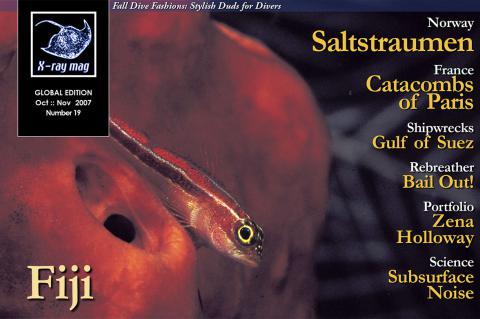Bailout on a rebreather
Bailing out to Open Circuit is like falling in the snow when you are learning to ski. It’s a solution when facing a problem—not always the most elegant solution, but always the easiest one, and most of the time, the most efficient one.
But Open Circuit bail-out is actually much more than simply going off the loop and breathing from another second stage. There are lots of possibilities.
Tags & Taxonomy
Sanity Breaths
When dealing with most of the problems that could occur with a rebreather—equipment failure, physiological problem, etc.—one of the first reactions should be to do a diluent flush to make sure you breathe a safe gas for the few seconds you’ll need to switch to OC and take some sanity breaths from a known mix.
Four or five breaths should help most of the divers experiencing any kind of symptoms to quickly regaining their ability to think properly and to react in the most efficient way. In case of hyperoxia, hypoxia, mild hypercapnia, or any mechanical or electronical problem, a good diluent flush followed by some sanity breaths can help. Even if this doesn’t help, most of the time it doesn’t do any harm (if the mix is safe to breathe at that depth), apart from depleting the stock of gas available.
These sanity breaths can be done in different ways:
BOV (Bail-out Valve)
That’s generally the easiest and fastest way. There is no need to remove the mouthpiece, so no stress. The BOV is already in the mouth, so no delay and no risk of drowning or panic. Therefore, a BOV is extremely useful, even required when diving with a Full-Face Mask. Some rebreathers come with a BOV fitted (Kiss, RB80, Cis-Lunar, etc), or it can be purchased separately (Golem Gear, Nemo, etc). The BOV is normally fitted to the on-board diluent but with a quick-connect, all your dreams can be fulfilled…
Open Loop technique
Still no need to go off the loop. The idea is to use the ADV as a kind of “manual 2nd stage”—obviously less convenient than a BOV, especially in case of a flooded loop. However, it’s one of the fastest options and can be so easily done that it should be one of the first skills to be taught to any CCR novice.
Standard 2nd stage
Fitted on a sling tank, it provides the diver with a sufficient and known source of gas. However, lots of rebreather divers simply store the complete regulator on the side of the sling tank. This configuration obviously requires more time than if the 2nd stage is stored on a shock cord loop around the neck. Remember, one of the goals of the sanity breaths is to quickly go off the loop to be able to safely breathe and think about the safest way to fix a problem. Looking for a few seconds for a second stage that is trapped somewhere (or even worse, loose) is not the best choice. Opening the tank valve also takes some time. If the 2nd stage is stored around the neck, the tank valve can be left open and any leak or free flow will then be easily spotted.
Combined regulator/2nd stage This is another option fitted on some rebreathers like the Inspiration and the Evolution. Some rebreather divers don’t like them as it might be difficult to breathe from them at depth. Other divers like the convenience and store them around the neck.
One of the problems with hypercapnia is the often-associated uncontrolled urge to breath. Closing and removing a DSV, then clearing a mouthpiece before being able to breathe is sometimes next to impossible. Because of the risk of water egress in the airway, a BOV is a convenient and safe way to gain control on the breathing pattern for a short period of time. It can only be a temporary measure before switching to a bigger stock of gas (off-board diluent/bail-out tank).
Download the full article ⬇︎

Originally published
X-Ray Mag #19
FIJI: Scott Bennett went to the far side of the Pacific and got the Royal treatment. Red Sea: Wreck hunter and author Peter Collings shows what all the latest craze is all about.
Our Norwegian friends takes us for spin in Saltstraumen, the most powerful drift dive on the planet - so buckle up.
Find out where all the noise in the Ocean come from and check out the Fall dive fashion before we go visit SeaCam and have a talk with Harald Hordosch about what it takes to become successful. Cerdic Verdier explains how to Bail out on a rebreather.
And finally Michel Ribera takes on a very spooky dive in the Parisian Netherworld - come see what the Catacombs hold. The Grande finale is presented by Zena Holloway - some amazing photography there.



